30 Nov Senior in Action – Don Schoendorfer
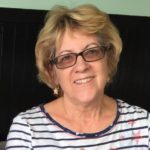
Marilee Marrero Stefenhagen
Former County of LA Public Library Administrator is having the time of her life as a retiree; meeting fascinating people who are active seniors, and volunteering for Soroptimist International of Norwalk and other women’s groups.
Re: photo taken in front of the waterfall:
The waterfall picture was taken at Mendenhall Lake in Alaska when we took our boat up
there.
Senior in Action – Don Schoendorfer
PhD by Marilee Marrero Stefenhagen, adapted from Schoendorfer’s memoir Miracle Wheels; The Story of a Mission to Bring Mobility to the World
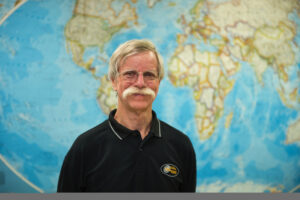 Don Schoendorfer is a biomedical engineer, inventor, entrepreneur, and humanitarian who lives in Santa Ana, California. Armed with an undergraduate degree from Columbia University and a PhD in mechanical engineering from Massachusetts Institute of Technology (MIT), Don spent nearly twenty-five years in the medical device industry, designing cutting-edge innovations resulting in more than sixty patents to his name.
Don Schoendorfer is a biomedical engineer, inventor, entrepreneur, and humanitarian who lives in Santa Ana, California. Armed with an undergraduate degree from Columbia University and a PhD in mechanical engineering from Massachusetts Institute of Technology (MIT), Don spent nearly twenty-five years in the medical device industry, designing cutting-edge innovations resulting in more than sixty patents to his name.
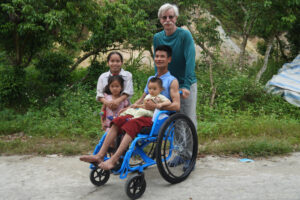 After a life-changing encounter overseas, and with a strong sense of God’s calling, Don founded Free Wheelchair Mission and made it his mission to address the problem of mobility around the world where 80 million people need wheelchairs but are unable to get one on their own. The innovative, cost-efficient wheelchairs that he developed and gave away for free – the “Miracle Wheels” – have transformed the lives of millions of people with disabilities. Don’s humanitarian work has garnered numerous awards, including the White House Call to Service Award in 2007 from President George W. Bush and the Congressional Medal of Honor Society “Above and Beyond Citizen award” in 2008 from General Colin Powell. Most recently, Don was recognized with the AARP Purpose Prize plus the prestigious AARP Inspire Award, which together awarded $60,000 that will transform more than 600 lives through the gift of mobility. Watch the video about Don’s inspiration and Free Wheelchair Mission here: https://www.aarp.org/about-aarp/purpose-prize/winners/info-2023/don-schoendorfer.html
After a life-changing encounter overseas, and with a strong sense of God’s calling, Don founded Free Wheelchair Mission and made it his mission to address the problem of mobility around the world where 80 million people need wheelchairs but are unable to get one on their own. The innovative, cost-efficient wheelchairs that he developed and gave away for free – the “Miracle Wheels” – have transformed the lives of millions of people with disabilities. Don’s humanitarian work has garnered numerous awards, including the White House Call to Service Award in 2007 from President George W. Bush and the Congressional Medal of Honor Society “Above and Beyond Citizen award” in 2008 from General Colin Powell. Most recently, Don was recognized with the AARP Purpose Prize plus the prestigious AARP Inspire Award, which together awarded $60,000 that will transform more than 600 lives through the gift of mobility. Watch the video about Don’s inspiration and Free Wheelchair Mission here: https://www.aarp.org/about-aarp/purpose-prize/winners/info-2023/don-schoendorfer.html
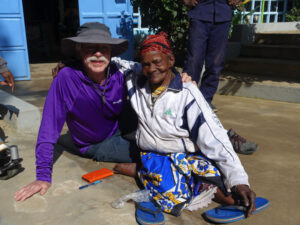 Here, from Don’s book, is how his journey began. “My parents met on a dude ranch, married in 1939, and went camping for their honeymoon. They lived through the Great Depression and lost what little money they’d had when the stock market crashed. “Donnie,” my mother would say, “You have to invest in education. That’s the one thing they can’t take away from you. Diamonds, gold – they’ll take it all, but not your education.” They were survivors, both of them, and they taught me to buy things only when you had the money. Debt wasn’t an option. They settled in Albany, NY, where I was born in 1949, five years after the arrival of my middle brother and nearly a decade after my oldest brother was born. A few years later, my father ended up taking a new job and my parents moved the family to Ashtabula, Ohio. We never had a lot of money. When something stopped working, we’d just keep repairing it. My father was good at fixing things. “There’s always a way to make things work,” he told me. When it came to mechanical and electrical repairs, there was never a shortage of wrenches, screwdrivers, and tools at our disposal.”
Here, from Don’s book, is how his journey began. “My parents met on a dude ranch, married in 1939, and went camping for their honeymoon. They lived through the Great Depression and lost what little money they’d had when the stock market crashed. “Donnie,” my mother would say, “You have to invest in education. That’s the one thing they can’t take away from you. Diamonds, gold – they’ll take it all, but not your education.” They were survivors, both of them, and they taught me to buy things only when you had the money. Debt wasn’t an option. They settled in Albany, NY, where I was born in 1949, five years after the arrival of my middle brother and nearly a decade after my oldest brother was born. A few years later, my father ended up taking a new job and my parents moved the family to Ashtabula, Ohio. We never had a lot of money. When something stopped working, we’d just keep repairing it. My father was good at fixing things. “There’s always a way to make things work,” he told me. When it came to mechanical and electrical repairs, there was never a shortage of wrenches, screwdrivers, and tools at our disposal.”
“Every Sunday, my parents drove to the train station to buy the NYT Sunday edition. One Sunday, my eyes landed on an intriguing article whose writer claimed that MIT was the best engineering school in the world. I felt the sudden rush of excitement. The best? In the entire world? Everything I ever wanted – my purpose, my destiny, my dream – was right there between my fingers. Flash forward to 1972 when my years at Columbia came to an end with a plan to focus on biomedical engineering for my doctoral work at MIT. To my great surprise and even greater relief, MIT offered me a full scholarship. After five grueling years, I successfully defended my PhD, and was slated for graduation. I interviewed for a job with a start-up company doing blood separation. With the job came a stock option, and I knew that would be key. With the right discovery, and with a financial stake in the company, I’d be positioned to do something significant in this world.”
“It was the summer of 1979, and I was twenty-nine years old. My wife Laurie and I were living outside Boston, with stable jobs. We were enjoying a two-week vacation in Spain, and adventure was calling. We rented a tan sedan in Gibraltar, crossed by ferry to Tangier, and embarked down the cinematic coast to Casablanca. Shortly before noon, we arrived at Tétouan, on the northern tip of Africa’s coast. We parked, hoping to do some shopping. The road veined away from the parking lot, and we followed it deeper into the bazaar, where merchants lined the street, hawking wares from their stalls. “
“That’s when I saw her. She was twenty feet from us, belly on the ground, as she clawed her way, inch by inch to the edge of the street, pulling herself across the uneven cobblestones. People were spilling around her as she kept her limbs close, trying to avoid being trampled. The sight of this woman stopped me cold in my tracks. “We have to do something,” I said to Laurie. But before we could gather our thoughts and figure out a way to help her, she had vanished into the crowd. Decades later, long after we left Morocco, her memory would surface once again. The seed planted in Tétouan would eventually blossom into a blueprint.”
My professional life blossomed, and within a few years, so did our family. Our first daughter arrived in 1981, and with the birth of our second, Laurie decided to quit her job and stay home. By the time our third arrived, Laurie had her hands full with spunky, spirited girls. I had my hands full as well. From my graduation from MIT until the mid-1990s, my career led me into the new and burgeoning field of blood cell separation. One of my daughters developed an eating disorder which she struggled with for years, trying different programs that didn’t work. Ultimately, one of her medical professionals created a custom program that helped her achieve victory. The journey that led to my daughter’s victory also led to God’s victory over my heart which started with the visit to the treatment facility in Arizona and continues to this day.”
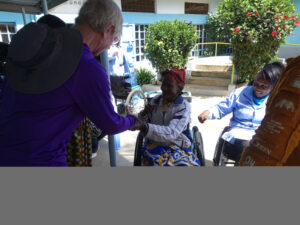 “In the same way my daughter’s doctor took a unique approach to her situation, my education allowed me to look at problems differently than a lot of people do when they develop a new concept. That was what motivated me to start Free Wheelchair Mission, a more efficient, effective solution to a gargantuan problem. At Free Wheelchair Mission, we think holistically about our mission. It begins with the engineering of the wheelchair and extends to the emotional well-being of the recipient, to the joy it brings to the recipient’s family and community, and ultimately, to making the world a better place.”
“In the same way my daughter’s doctor took a unique approach to her situation, my education allowed me to look at problems differently than a lot of people do when they develop a new concept. That was what motivated me to start Free Wheelchair Mission, a more efficient, effective solution to a gargantuan problem. At Free Wheelchair Mission, we think holistically about our mission. It begins with the engineering of the wheelchair and extends to the emotional well-being of the recipient, to the joy it brings to the recipient’s family and community, and ultimately, to making the world a better place.”
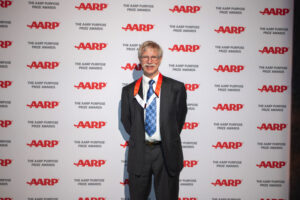 “My prayer is that by sharing a few stories of my life, you will discover your own blueprints for life, your own contributions to humanity, and your own calling and purpose within the kingdom of God, no matter how big or small. The legacy I’d like to leave the world is to open doors of possibility for those who cannot walk, to lift them up, give them mobility, and tell them, “When you’re in this wheelchair, we want you to feel like you’re in God’s hands, that He’s protecting you.”
“My prayer is that by sharing a few stories of my life, you will discover your own blueprints for life, your own contributions to humanity, and your own calling and purpose within the kingdom of God, no matter how big or small. The legacy I’d like to leave the world is to open doors of possibility for those who cannot walk, to lift them up, give them mobility, and tell them, “When you’re in this wheelchair, we want you to feel like you’re in God’s hands, that He’s protecting you.”
For more information about Free Wheelchair Mission, and how you might get involved, visit www.freewheelchairmission.org or order a copy of Don’s memoir, Miracle Wheels: The Story of a Mission to Bring Mobility to the World from Amazon




Sorry, the comment form is closed at this time.